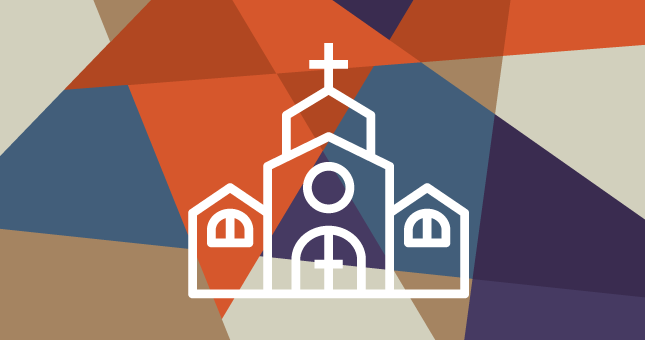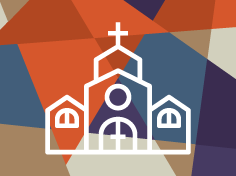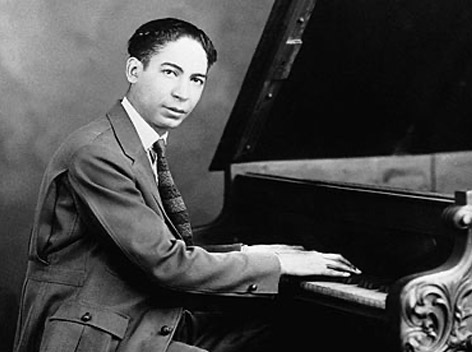
Illustration by Micah Hill
Learning to See Ourselves
Ethnic Minority Churches in a Multicultural World
“Can you read?” asked the man, his belligerent tone catching me off guard.
“Excuse me?” I gingerly replied. (As a person of Chinese descent, I wasn’t particularly enthused with the direction this conversation was taking.)
“Can you read?” he repeated, motioning toward a sign at the front of the Regent Bookstore, where I had just started my shift. Incidentally, I had written that sign the night before: “We will be closed until 3 pm (or so) today for our annual inventory count.” Inventory had taken longer than usual, and it was now almost 4.
Composing myself, I began to apologize for the delay but was quickly interrupted. “Can you read?” he shouted, enunciating each word before tossing a book into the air and storming off.
“Yes sir, I can read.”
***
Stories like these are all too common among people of colour in North America. They bear the same familiar characteristics—unprovoked outbursts tinged with thinly veiled overtones that imply we are foreigners in our own land. The relative infrequency of such incidents doesn’t lessen their impact; to the contrary, they remind ethnic minorities that racial resentment can punch through society’s thin layer of multiculturalism whenever it pleases. Recent events such as the distribution of anti-Chinese flyers in Richmond and the (failed) attempt to organize a white nationalist rally at Vancouver City Hall suggest that this is not the post-racial utopia many believe it to be.
Within the North American evangelical community, it is often ethnic minority churches that bear the weight of these realities. Their very existence is a response to the shifting tectonics of culture, economics and geography, yet their unique identity within the church is too often flattened or overlooked. What, then, is their place within the larger evangelical world? To explore this question, I spoke with three former Regent students who were raised in Chinese churches across North America: Rev. Joshua Koh of Fraser Lands Church in Vancouver, Rev. Allan Tan of Church of the Good Shepherd (one of Vancouver’s first Chinese Anglican churches), and Dr. Justin Tse, a Vancouver-born cultural geographer who teaches Asian American studies at Northwestern University, Illinois. Our conversations coalesced around three themes: the framework of multiculturalism in Vancouver; the ways in which multiculturalism helps and harms multiethnic churches; and the role that ethnic minority churches can play within the wider church body. While our discussions drew deeply from the Chinese immigrant experience, they have profound implications for the broader church as it discerns how to love its neighbours in dignifying, rather than colonizing, ways.
The Problem of Richmond
To describe Vancouver as “multicultural” is a cliché. In 2006, the local census reported that over half of the city’s inhabitants grew up with a first language other than English, and by 2016 visible minorities constituted almost fifty percent of its population (my daily commutes to UBC seem to bear this out). Multiculturalism is well established as one of the dominant frameworks by which Vancouverites orient and order their daily lives. The city also has its own local quirks, which Tse—who earned his Ph.D. studying Cantonese Protestants in the Pacific Rim—helps to unpack. “In Vancouver,” he says, “you’re right to say that the term ‘multiculturalism’ is often used. But it’s as if people want to talk about race, and don’t want to talk about race.” In contrast to the vigorous discourse that he encounters in Chicago, Vancouver’s distinct vision of multiculturalism trades in the language of race for that of “shared values, tolerance, politeness, and diversity.”
One consequence of this vision, Tse points out, is the way that Vancouver’s Chinese community is often described as “private” and self-contained (or more recently, as voracious consumers of real estate). The way that multiculturalism feeds into these perceptions is, to use his own term, “very weird.” “It’s almost as if the accusation is that Chinese people are not being multicultural because they keep to themselves, and because of this they’re not ‘integrating.’” What then, he asks, does multiculturalism mean in Vancouver? Is it a harmonious mosaic, a preview of the great denouement in which all nations worship together before Christ’s throne? His answer is stark, but incisive: “No, not really. What it really means is that there is a mainstream society that is framed as multicultural, and [that people] use words like ‘shared values,’ ‘tolerance,’ ‘multiculturalism,’ ‘diversity,’ and ‘inclusion’ to describe that space. And for some reason, Chinese people are outside of that space.”
This, I can tell, is going to be quite the conversation.
Majority Rules
Within the wider North American evangelical sphere, one of the most prevalent ways in which multiculturalism impinges upon conversations about race is through the adoption of the terms “majority” and “minority.” While originating in sociology, these terms are now a staple in evangelical discussions on culture, mission, and global Christianity. Regarding this development, Tse is refreshingly blunt: “‘Majority culture, minority culture’—[these] are words that are used so that people don’t have to say the word ‘white.’” “This,” he continues, “gets us into the territory of what whiteness is.”
I grip my pen a little tighter. “Whiteness” is seldom brought up in evangelical communities; it’s part of the furniture of North American life, and as such is often easier to ignore. Such avoidance, however, renders us blind to even the most basic realities of race. What is whiteness? Tse’s perspective is that it is linked to the “erasure”—or loss—of one’s European cultural heritage. Hence, “you’ll hear white people refer to themselves as ‘not having a culture,’ whereas you have a culture if you’re a person of colour.” As a supposedly “culture-less” identity, whiteness is frequently construed in racially neutral terms (e.g. “majority” and “minority”). Unfortunately, these terms have fostered a broadly circuitous discourse wherein “‘majority culture Christians’ are people who have forgotten that they have a culture, and ‘minority culture Christians’ are people who are constantly reminded by people in the majority that they have a culture.”
The Integration Game
What does this mean for ethnic minority congregations? How do they respond to multiculturalism’s strange dichotomies? According to Koh (who has served extensively in Taiwanese and Cantonese immigrant churches for over two decades), they don’t—at least not on the surface. After pastoring at a predominantly white church for several years, he was surprised by the extent to which the congregation at his next church downplayed their ethnic identity, even though they were the first Chinese church of their denomination in the city. “They almost went out of their way to try not to highlight it,” he recalls. “It’s as if they don’t want [ethnicity] to be an identity marker for them as a Christian in Canada.” This sentiment is especially pronounced among those in his English-speaking congregation, who “want to understand themselves as integrated Canadians in the larger Canadian society.”
Speaking from his Chinese Anglican context, Tan acknowledges that for many members, these questions remain “largely subconscious.” In this respect, multiculturalism “is helpful where it identifies just how mixed Vancouver is . . . but it also feels like a premature pat on the back—it doesn’t acknowledge some of our deep differences, especially some of our unflattering history, and where there’s still significant healing, reconciliation and justice to come.” This gap is reflected in the concerns that emerge from among his own congregation’s leaders: “How do we fit into the larger church? Are we valued as a voice? And do people understand what we’re doing—the challenges of reaching minorities, or even the rationale of reaching minorities?” In both congregations one can detect the threads which Tse touched upon: the internalized pressure to “integrate” into the mainstream on the one hand, and the conspicuous absence of clear, well-defined terms with which to engage in meaningful dialogue on the other.
Guilt Gone Wild
Within many immigrant churches, this impulse to integrate comes with an acutely painful side effect: namely, the loss of their younger generations to “mainstream” churches. In fact, it was not uncommon throughout my classes at Regent to hear Asian students lament and even apologize for the existence of their own ethnic churches, which they bemoaned as outmoded bastions of self-segregation. (Confession: when I first moved to Chicago for college, I was firmly within this camp.) While sympathetic to the clash of family, culture, and value systems that the second generation experiences, Koh wonders if these sentiments stem in part from the “self-deprecating shame” that minorities often internalize as a result of their foreignness. This shame can easily be projected onto their own church communities, especially when their pastors and worship leaders “aren’t the ones being invited to big conferences, or speaking and writing books.” Tan, too, adds that “there is a certain preconceived notion of what a vibrant, powerful, successful pastor is, and we see that it commonly intersects with a certain demographic.”
Tse takes this analysis a step further: he links this experience of shame to the phenomenon of white guilt, which “moves in two directions.” “First,” he observes, “white guilt can cause people to embrace the rhetoric of multiculturalism. Second, white guilt can cause white people to be resentful of the rhetoric of multiculturalism.” The way this percolates into minority churches is (again) “very weird,” because the first generation “are accused by their own children, and the white churches, of not being multicultural, [since] they’re Chinese, Ukrainian, Peruvian, or Greek.” This amounts to “the rhetoric of white guilt seeping into the minority culture churches and telling them how to be ‘cultural’ Christians.” In an ironic twist, the second and third generations end up imposing white guilt onto their parents and, without realizing it, “normalizing white Christianity, as if white Christianity were not an enculturated form of Christianity.”
A Higher Calling
Having explored the landscape of multiculturalism and its effects on congregational life, we can now ask, what is the role of ethnic minority churches within the larger church body? Koh affirms their cultural distinctiveness as an indispensable gift. “I do think that they have a particular mission because of their strengths in particular languages,” he explains. “There’s something about being introduced to Jesus in your own heart language that is healthier [for] a deeper level of discipleship.” At the same time, Koh reminds us that the existence of ethnic-specific churches should prompt Christians to step outside of their own cultural stomping grounds: “majority culture churches are worse off if they’re not interacting with, being discipled by, and learning from minority churches—and vice versa.”
Although such interactions may require considerable effort, Tse stresses the importance of engaging in the gospel and liturgy “as a whole person.” “I don’t need to assimilate [or] buy into some kind of dominant majority form,” he explains, “because when the Lord speaks to me, he is not colonizing me; he is inviting me into the risen life of Jesus Christ.” Accordingly, Tse encourages the second generation to learn their parents’ cultural stories in English, and to allow these to inform their practices of worship. Recalling his own parents’ hardships as refugees, Tan envisions minority churches as the “front line” for welcoming immigrants—one where “our cultural identity and language is [recognized as] a precious and inviolable part of our human identity.” A minority church should therefore be “a place of safety” which encourages “the flourishing and integration of that cultural identity within the larger whole.”
Ah, integration—there’s that word again. What does this look like, I ask? Tan replies slowly, carefully mulling over his words. “I think in the early church, when Jew and Greek [are called] to integrate, there is a sort of mutual transformation that can happen whenever meaningful, loving relationship occurs. It’s not either party brushing aside their own ethnic identity, distinctives, and language, but we see a mutual sharing of life.” True integration is therefore a “mutual transformation out of love for each other,” which utterly transcends multiculturalism and finds its fulfillment in a much higher calling: namely, to be the body of Christ. Koh agrees: “At the core of the gospel is this movement to the other, and this movement beyond our home culture.” His voice picks up steam: “We are called,” he insists, “to live in that new humanity, which is both Jew and Gentile, and which breaks down hostilities. That’s the nature of it—God’s desire for peace.”
***
Peace. The word calls to mind the singular witness of Dr. Martin Luther King Jr., who recognized that peace is not merely the absence of conflict, but the abiding fullness of justice and love. Earlier this year we observed the fiftieth anniversary of his assassination, and in April, many mourned the loss of the renowned black theologian, Dr. James Cone. When I asked Tse what these figures might teach us about the role of minority churches today, his reply was unequivocal: they show us what it means to decolonize the body of Christ. “Minority churches,” he observes, “understand colonialism in their bones.” Thus, “there is the possibility of people who grew up in these churches beginning to reflect on their practices, and developing something new.” I suspect that he’s right; as people of colour, we know what it is to live in a colonized world—and nevertheless, to read.


